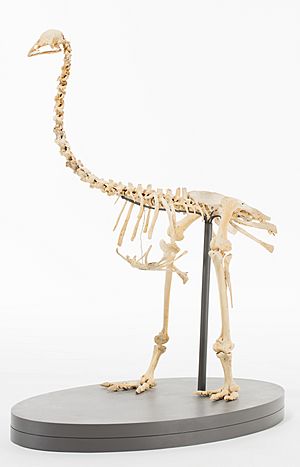Mantell's moa facts for kids
Quick facts for kids Mantell's moaTemporal range: Pleistocene- Late Holocene
|
|
|---|---|
 |
|
| from the collection of Auckland Museum | |
| Conservation status | |
| Scientific classification | |
| Genus: |
Pachyornis
|
| Species: |
geranoides
|
| Synonyms | |
|
List
Palapteryx geranoides Owen, 1848 non Euryapteryx geranoides Checklist Committee 1990
Dinornis geranoides (Owen 1848) Owen 1866 Anomalopteryx geranoides (Owen 1848) Lydekker, 1891 Cela geranoides (Owen 1848) Hutton 1891 Dinornis curtus Owen 1871 non Owen 1846 Anomalopteryx curta (Owen 1871) Lydekker 1891 Pachyornis pygmaeus Hutton 1895 non Euryapteryx pygmaeus Hutton 1891 Dinornis expunctus Archey, 1927 Pachyornis septentrionalis (Oliver 1949) Brodkorb 1963 Pachyornis mappini Archey, 1941 |
|
Mantell's moa (Pachyornis geranoides) was a large bird from New Zealand. It was also known as Mappin's moa. This amazing bird is now extinct, meaning it no longer lives on Earth.
Mantell's moa belonged to the Moa family. These birds lived only on the North Island of New Zealand. They were very common in low-lying areas.
Contents
About Mantell's Moa
Mantell's moa was a type of bird called a ratite. Ratites are special because they cannot fly. Other famous ratites include ostriches and emus.
Why Moa Couldn't Fly
Birds that can fly have a strong bone called a sternum with a keel. This keel is where their powerful flight muscles attach. Mantell's moa, like other ratites, had a sternum without this keel. This meant they could not develop the strong muscles needed for flight. Their mouths also had a special shape, called a distinctive palate.
Where Mantell's Moa Lived
These moa birds loved living in the lowlands of New Zealand's North Island. Their homes included different types of environments. They lived in areas with shrubs, open grasslands, and even sandy dunelands. They also made their homes in forests.
The Moa's Ancient Family
Scientists are learning more about where moa birds came from. It is now thought that the very first ancestors of these birds could actually fly. These flying ancestors likely flew to the southern parts of the world. Over a very long time, they changed and lost the ability to fly. This is where the remains of moa birds have been found.

